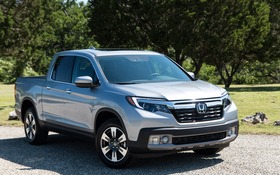2017 Honda Ridgeline: The Most SUV-ish of Pickups

| Strong points |
|
|---|---|
| Weak points |
|
The Ridgeline can be seen as a niche product. The automaker never sold many of them, but this weird-looking pickup truck succeeded in creating a circle of tightly knit enthusiasts, which is asking for more.
That’s the main reason behind Honda’s decision to go ahead and develop a second-generation model. The previous Ridgeline, which was offered up until 2014, sold less than 2000 units in Canada during its last year on the market. For 2017, Honda is expecting to move out about 4000 units.
Still, the Ridgeline is a profitable product for Honda, as most units sold of the previous generation were the fully-equipped versions.
After a couple of days behind the wheel, we realized that the Japanese automaker doesn’t want to simply duplicate what everybody else is doing in the midsize pickup segment that includes the Toyota Tacoma, the Chevrolet Colorado, the GMC Canyon and the Nissan Frontier.
On paper
Honda’s marketing people were clear on one thing: the 2017 Honda Ridgeline seeks to be the most comfortable pickup truck sold in North America. Possibly on the planet.
In fact, it’s easy to understand why, as the Ridgeline and the Pilot share the same platform. Inside, it’s hard to tell the two vehicles apart when we look at the dashboard.
For a pickup truck, the rear seats are pretty accommodating, and the cushions can be flipped upwards to transform this row of seats into a storage space, capable of swallowing a mountain bike, for example.
The suspension has little to do with that of a normal pickup, and when we look closely, it’s globally the same setup as what’s found underneath a Pilot. However, the components have been beefed up in order to haul various objects in the bed without sacrificing ride comfort.
Which brings us to the powertrain. It includes the company’s 3.5-litre V6, the same one as in the Honda Pilot and the Honda Accord, which develops 280 horsepower here. It’s matched to a six-speed automatic transmission, programmed to accelerate more quickly than the previous generation’s gearbox, but also to deliver better fuel economy. The first and second gears are shorter, while fifth and sixth are taller.
This engine allows the Ridgeline to tow a maximum load of 5000 lbs. (2268 kg), same as in the first generation. That’s not nearly as much as the 6400-lb. capacity of the Toyota Tacoma. However, according to Honda’s research, 95% of owners of this type of truck will never need more than that.
The Ridgeline can also carry a payload of up to 1571 lbs. (713 kg) in its bed, which is 42 lbs. more than in the previous generation. An impressive number, considering the Ram 1500 equipped with its 3.6-litre V6 can only carry 1440 lbs. in its 6.4-foot bed.
Speaking of which, the Ridgeline’s bed is wide enough at five feet, but its 5.4-foot length will not suit the needs of everyone. With the tailgate down, length grows to 7 feet, but still.
This bed is nonetheless practical with its underfloor trunk and tailgate that can be opened conventionally or on the side. An interesting fact is that the plastic bed panels can serve as a speaker in the Touring version, so everyone can listen to music while camping or during a tailgate party before the game.
No true 4x4 system here, but an all-wheel drivetrain with a twin-clutch differential, same as what’s found in Acura’s SH-AWD setup and in the Honda Pilot, but modified to make it more robust.
Against the competition, with comfort as ammo
Honda wanted to sell us their truck’s comfort levels during our first drive of the 2017 Ridgeline. The automaker brought us to an off-road course where we could drive the Toyota Tacoma, the Chevrolet Colorado and the Ridgeline back to back.
In mud and sand, the Ridgeline’s intelligent all-wheel drive system succeeded every time in detecting the type of terrain and adapting itself accordingly, performing as well as the other trucks’ 4WD systems.
However, from a comfort standpoint, it’s day and night, as the Ridgeline’s suspensions are more civilized than the others. Same result during a race on a grassy surface that Honda had set up, on which the rival midsize pickups rode pretty stiff.
During our towing tests, the Ridgeline performed effortlessly, although the loads weren’t very high. However, as is often the case, body sway was perceptible.
One thing’s for certain is that the Ridgeline doesn’t drive like a pickup. Its ride is a lot less jittery, but doesn’t offer that truck-ish feel that some people like. Its rather short box might displease a few shoppers, while its 5000-lb. tow capacity, same as the majority of midsize SUVs, gives the Ridgeline more of a practical SUV personality than a pickup one.
Still, it’s a well-engineered truck that will sell for $36,000 in base LX trim, and up to $48,590 in fully equipped, Black Edition guise.











